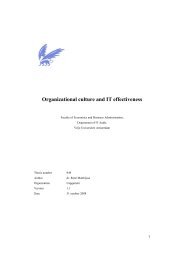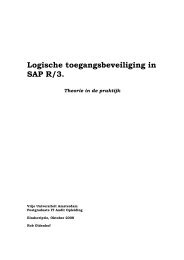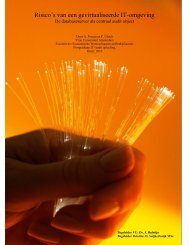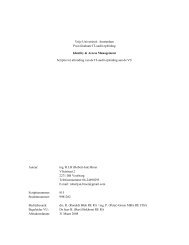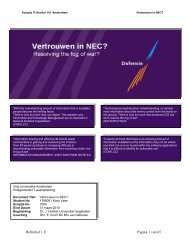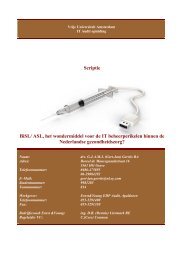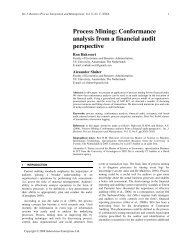Usability and Security
Usability and Security - Vurore
Usability and Security - Vurore
Create successful ePaper yourself
Turn your PDF publications into a flip-book with our unique Google optimized e-Paper software.
conclude that the most efficient biometric types are Iris <strong>and</strong> fingerprint, followed by face <strong>and</strong>h<strong>and</strong>print. Retina takes a long time for scanning, thus not efficient. We therefore consider all typeswith the exception of the retina type;• Satisfaction: the users’ goal with satisfaction is a positive attitude towards getting access to asystem or building, without encountering any discomfort. Based on the discussions above we canconclude that the Iris, fingerprint, face <strong>and</strong> h<strong>and</strong>print types are effortless to use. Most convenient isfingerprint, followed by h<strong>and</strong>print <strong>and</strong> face. We therefore consider all types with the exception ofthe retina type.<strong>Security</strong> aspects:• Confidentiality: in this aspect the property that information is not made available to unauthorizedindividuals is important. However biometrics concerns the component “something you are”. Therisk of obtaining a ‘finger’ to forge the fingerprint reader or have access by identical siblings isconsidered very low. Based on the discussions above we can conclude that in this case the mostsecure biometric types are Iris, fingerprint <strong>and</strong> retina;• Integrity: in this aspect the property of safeguarding the accuracy <strong>and</strong> completeness of assets isimportant. Same explanation as confidentiality;• Availability: in this aspect the property of being accessible <strong>and</strong> usable upon dem<strong>and</strong> by anauthorized user, in this case getting access to a building or remote access is important. Sameexplanation as confidentiality.In this paragraph we have seen that the different biometric technologies have a wide range of accuracy,reliability <strong>and</strong> usability. The actual performance of these devices are measured using False Accept Rates(FAR), False Reject Rates (FRR) <strong>and</strong> depend on the number of reference points <strong>and</strong> algorithms used. Eachbiometric type has its strengths <strong>and</strong> weaknesses <strong>and</strong> is primarily used for physical <strong>and</strong> information systemaccess.The table below illustrates the results of our classification based upon the analyses performed in thisparagraph:Aspects<strong>Usability</strong><strong>Security</strong>Types of biometricsEffectiveness Efficiency Satisfaction Level Confidentiality Integrity Availability LevelH<strong>and</strong>print x x Moderate LowFingerprint x x x High x x x HighIris x x x High x x x HighRetina x Low x x x HighFace x x Moderate LowTable 6: Biometric type levelsThe relationship between usability <strong>and</strong> security will be discussed in chapter five.22




